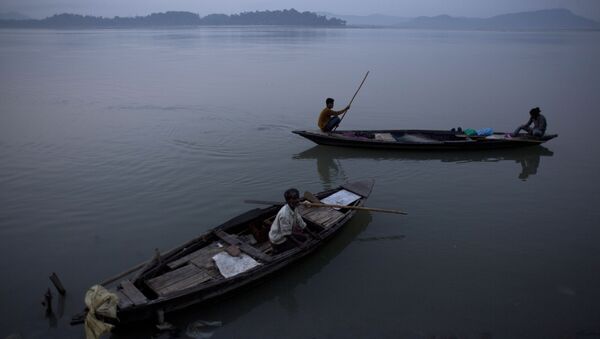New Delhi (Sputnik) — The Indian government has expedited the process of getting clearances for four proposed projects to build reservoirs to store water from the Brahmaputra River and its tributaries amid fresh reports of Chinese threats to divert the river's water to its arid regions. An inter-ministerial meeting was held recently to discuss the proposed projects.
Water has emerged as the new divide in Sino-Indian ties, and China, being an upper riparian state, is going to use it as a weapon against India, a lower riparian state, say experts.
"Water has definitely become a bone of contention between India and China. And it is related to conflict over resources as well as the boundary dispute. Moreover, the water conflict could have ramifications for other countries in the region and shape their strategic thinking," Dr. Jagannath Panda, a research fellow at the New Delhi-based Institute for Defence Studies and Analyses, told Sputnik.
India wants to ensure that it has enough water to sustain its hydropower projects and irrigation during the lean seasons should China divert the Brahmaputra's flow in the upper reaches. The idea is based on a worst-case scenario assessment. An added incentive is to help control the floods in the northeastern state of Assam.
India reportedly wants to store around 14.8 billion cubic meters of water to ensure continuous supply to the four proposed hydropower projects on the Siang and its tributaries including the Lohit, Subansiri and Dibang Rivers in Arunachal Pradesh.
However, the projects have been facing stiff opposition from locals, who are not satisfied with the amount of money the government has allocated to acquire land for the projects, and bear environmental concerns. The Centre has sought the views of the governments of Assam and Arunachal Pradesh on whether it would be feasible to offer higher compensation for the land acquisition.
As far as the hydropower projects or any other infrastructure in the northeast is concerned, India's actions are shaped by China. India and China's ties have now entered into a complex phase and a lot of policy decisions on both sides are now being considered keeping the other in mind.
"Also, let's be clear that China has been planning to divert water from the Brahmaputra to its arid regions from last one and a half decade and it is not something of a recent process, which again brings into focus conflict over resources," says Dr Jagannath Panda, author of India-China Relations: Politics of Resources, Identity and Authority in a Multipolar World Order.
The fact that China claims 90,000 square km of Arunachal Pradesh as its own, and in the past has objected to Indian ministers or others visiting the state, sustains suspicion. Earlier this year, Beijing objected to the Dalai Lama's visit to a Buddhist monastery in Arunachal Pradesh.
And later, for 73 days, both sides were engaged in a protracted border standoff on the Doklam Plateau. One of the fallouts of the Doklam crisis was India blaming China for not sharing its hydrological data on the Brahmaputra River, which had contributed to floods in Assam.




